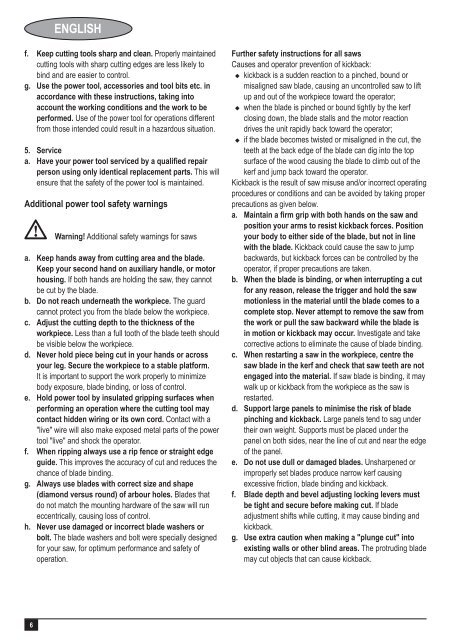BlackandDecker Scie Circulaire- Ks40 - Type 1 - Instruction Manual (Européen)
BlackandDecker Scie Circulaire- Ks40 - Type 1 - Instruction Manual (Européen)
BlackandDecker Scie Circulaire- Ks40 - Type 1 - Instruction Manual (Européen)
You also want an ePaper? Increase the reach of your titles
YUMPU automatically turns print PDFs into web optimized ePapers that Google loves.
ENGLISH<br />
f. Keep cutting tools sharp and clean. Properly maintained<br />
cutting tools with sharp cutting edges are less likely to<br />
bind and are easier to control.<br />
g. Use the power tool, accessories and tool bits etc. in<br />
accordance with these instructions, taking into<br />
account the working conditions and the work to be<br />
performed. Use of the power tool for operations differ<strong>en</strong>t<br />
from those int<strong>en</strong>ded could result in a hazardous situation.<br />
5. Service<br />
a. Have your power tool serviced by a qualified repair<br />
person using only id<strong>en</strong>tical replacem<strong>en</strong>t parts. This will<br />
<strong>en</strong>sure that the safety of the power tool is maintained.<br />
Additional power tool safety warnings<br />
@ Warning! Additional safety warnings for saws<br />
a. Keep hands away from cutting area and the blade.<br />
Keep your second hand on auxiliary handle, or motor<br />
housing. If both hands are holding the saw, they cannot<br />
be cut by the blade.<br />
b. Do not reach underneath the workpiece. The guard<br />
cannot protect you from the blade below the workpiece.<br />
c. Adjust the cutting depth to the thickness of the<br />
workpiece. Less than a full tooth of the blade teeth should<br />
be visible below the workpiece.<br />
d. Never hold piece being cut in your hands or across<br />
your leg. Secure the workpiece to a stable platform.<br />
It is important to support the work properly to minimize<br />
body exposure, blade binding, or loss of control.<br />
e. Hold power tool by insulated gripping surfaces wh<strong>en</strong><br />
performing an operation where the cutting tool may<br />
contact hidd<strong>en</strong> wiring or its own cord. Contact with a<br />
"live" wire will also make exposed metal parts of the power<br />
tool "live" and shock the operator.<br />
f. Wh<strong>en</strong> ripping always use a rip f<strong>en</strong>ce or straight edge<br />
guide. This improves the accuracy of cut and reduces the<br />
chance of blade binding.<br />
g. Always use blades with correct size and shape<br />
(diamond versus round) of arbour holes. Blades that<br />
do not match the mounting hardware of the saw will run<br />
ecc<strong>en</strong>trically, causing loss of control.<br />
h. Never use damaged or incorrect blade washers or<br />
bolt. The blade washers and bolt were specially designed<br />
for your saw, for optimum performance and safety of<br />
operation.<br />
Further safety instructions for all saws<br />
Causes and operator prev<strong>en</strong>tion of kickback:<br />
u kickback is a sudd<strong>en</strong> reaction to a pinched, bound or<br />
misaligned saw blade, causing an uncontrolled saw to lift<br />
up and out of the workpiece toward the operator;<br />
u wh<strong>en</strong> the blade is pinched or bound tightly by the kerf<br />
closing down, the blade stalls and the motor reaction<br />
drives the unit rapidly back toward the operator;<br />
u if the blade becomes twisted or misaligned in the cut, the<br />
teeth at the back edge of the blade can dig into the top<br />
surface of the wood causing the blade to climb out of the<br />
kerf and jump back toward the operator.<br />
Kickback is the result of saw misuse and/or incorrect operating<br />
procedures or conditions and can be avoided by taking proper<br />
precautions as giv<strong>en</strong> below.<br />
a. Maintain a firm grip with both hands on the saw and<br />
position your arms to resist kickback forces. Position<br />
your body to either side of the blade, but not in line<br />
with the blade. Kickback could cause the saw to jump<br />
backwards, but kickback forces can be controlled by the<br />
operator, if proper precautions are tak<strong>en</strong>.<br />
b. Wh<strong>en</strong> the blade is binding, or wh<strong>en</strong> interrupting a cut<br />
for any reason, release the trigger and hold the saw<br />
motionless in the material until the blade comes to a<br />
complete stop. Never attempt to remove the saw from<br />
the work or pull the saw backward while the blade is<br />
in motion or kickback may occur. Investigate and take<br />
corrective actions to eliminate the cause of blade binding.<br />
c. Wh<strong>en</strong> restarting a saw in the workpiece, c<strong>en</strong>tre the<br />
saw blade in the kerf and check that saw teeth are not<br />
<strong>en</strong>gaged into the material. If saw blade is binding, it may<br />
walk up or kickback from the workpiece as the saw is<br />
restarted.<br />
d. Support large panels to minimise the risk of blade<br />
pinching and kickback. Large panels t<strong>en</strong>d to sag under<br />
their own weight. Supports must be placed under the<br />
panel on both sides, near the line of cut and near the edge<br />
of the panel.<br />
e. Do not use dull or damaged blades. Unsharp<strong>en</strong>ed or<br />
improperly set blades produce narrow kerf causing<br />
excessive friction, blade binding and kickback.<br />
f. Blade depth and bevel adjusting locking levers must<br />
be tight and secure before making cut. If blade<br />
adjustm<strong>en</strong>t shifts while cutting, it may cause binding and<br />
kickback.<br />
g. Use extra caution wh<strong>en</strong> making a "plunge cut" into<br />
existing walls or other blind areas. The protruding blade<br />
may cut objects that can cause kickback.<br />
6
















